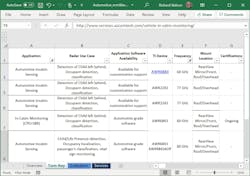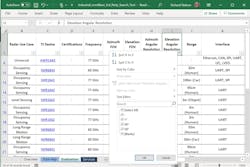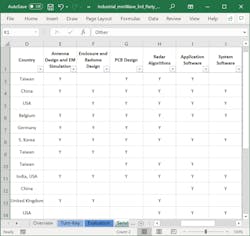Ecosystem Eases Implementation of mmWave Radar Sensor Systems
Members can download this article in PDF format.
Millimeter-wave (mmWave) radar sensors can detect objects and provide data regarding their range, velocity, and angle to your system. Operating between 30 and 300 GHz, contactless mmWave radar employs short wavelengths to provide sub-millimeter range accuracy while achieving high resolution.
Radar can penetrate materials such as plastic, drywall, and clothing. Unlike optical time-of-flight sensors, radar sensors work reliably in rain, fog, dust, and snow, and they can detect transparent and dark surfaces. Moreover, mmWave radar’s short wavelengths enable physically compact system components such as antennas.
Texas Instruments’ mmWave radar portfolio includes automotive (AWR) and industrial (IWR) devices, which are single-chip CMOS sensors that integrate an RF front end with various combinations of digital signal processor (DSPs), fast-Fourier-transform (FFT) accelerators, MCUs, and memory. They operate at 60 and 77 GHz, and you can cascade multiple mmWave sensors to provide LiDAR-like angular resolution.
The sensors come with a mmWave software development kit (SDK) that lets experienced radar engineers quickly evaluate and enable their sensor projects. However, if you’re transitioning from another sensing technology or are otherwise new to radar, you could face a steep learning curve when trying to both develop your product and ramp up production, and you may need help.
Sponsored Resources:
- Technical article: Designing TI mmWave radar made easier using our third-party ecosystem
- View our 3rd party search tool
- Looking to get started with TI mmWave radar sensors?
Third-Party Search Tool
To lower the barriers to effective radar design and production, Texas Instruments has created a third-party ecosystem of radar experts who can provide solutions no matter what level of help you need. For example, you might need assistance with radar-specific engineering challenges that can represent pain points in the design process, such as radio-frequency and antenna design, radar algorithm development, system software development, and certification consulting.
Conversely, you might want to purchase a complete radar module that integrates a TI mmWave chip, an antenna, a power supply, and peripheral interconnect. Some of these complete modules come with weatherproof enclosures and industry or regulatory certifications.
Whatever your requirements, TI’s ecosystem aims to connect you with the third party that best meets your needs without wasting time with fruitless web searches and endless phone calls. Two Excel spreadsheets—the “Automotive mmWave 3rd Party Search Tool” and the “Industrial mmWave 3rd Party Search Tool”—serve as a map to the ecosystem. When you download the search tools, you’ll find that each opens on an overview sheet, which introduces the tool, provides instructions, and defines terms. The next three sheets—labeled “Turn-Key,” “Evaluation,” and “Services”—form the heart of each tool.
The Turn-Key sheet serves engineers looking for complete end-to-end hardware and software solutions. Figure 1 shows a portion of this sheet for the Automotive search tool. You can search for products by application, use case, application software availability, the TI device integrated into the solution, the radar frequency, module mounting information, and certification status.
Not shown in Figure 1, but included in all Turn-Key sheets, are the company, the company country, the product name and number, the target country, a company link, a product link, and an email address for an engineer or team who can help with your turn-key product selection.
The Evaluation sheet serves engineers looking for a hardware solution, often with demo software, to accelerate the development process. Figure 2 shows the Evaluation sheet for the Industrial search tool highlighting use case, the integrated TI device, certification status, frequency, azimuth and elevation field of view and angular resolution, range, and communication interfaces.
For all sheets in both tools, other than the Overview sheet, you can use the Excel filter function to zero in on your preferred solution with respect to region, application, and performance specification. Figure 2, for example, illustrates a drop-down check box that lets you choose your preferred elevation angular resolution parameters. Not shown in the truncated Figure 2 are application information and mechanical dimensions as well as complete company, product, country, and contact information.
Finally, the Services sheet in each tool enables you to locate companies who can help with antenna design and EM simulation, enclosure and radome design, and PCB design as well as radar-algorithm, application-software, and system-software development. Once again, the Services sheet provides complete company contact information to help you get the assistance needed for your radar project. Figure 3 shows a portion of the Services sheet for the Industrial search tool.
Sensor Overview
An overview of TI’s AWR and IWR sensors can help get you started on your third-party search if you choose to filter by TI device model number. For automotive applications, the four-chip cascaded 76- to 81-GHz AWR2243 works at short ranges over a wide field of view while extending operation out to long distances. The AWR1443 and AWR1642 single-chip 76- to 81-GHz sensors target ultra-short range radar; the former integrates an MCU and hardware accelerator, while the latter integrates a DSP and MCU.
Several other AWR products serve medium- and short-range applications with various combinations of DSPs, MCUs, and accelerators. In addition, the AWR6843 single-chip 60- to 64-GHz sensor integrates a DSP, MCU, and radar accelerator to provide a noncontact method for measuring driver vital signs, such as heart rate and breathing rate. Other AWR devices offer obstacle detection during parking and door opening, and still others support vehicle occupant detection, including child-left-behind detection.
Products for industrial applications include the 60- to 64-GHz IWR6843AoP intelligent edge sensor with an antenna-on-package (AoP), the 60- to 64-GHz IWR6843 intelligent edge sensor without an integrated antenna, the IWR1843 76- to 81-GHz intelligent edge sensor, and the IWR1443 76- to 81-GHz low-power sensor. Such sensors enable efficient, self-monitored, accurate radar systems in industrial applications such as building automation, factory automation, drone operation, material handling, traffic monitoring, and surveillance.
Conclusion
mmWave radar sensors represent an effective technology for getting intelligence about an object’s range, velocity, and angle into your system. If you’re new to radar, Texas Instruments’ third-party search tools can guide you to the products and expertise you need within TI’s third-party ecosystem for your automotive or industrial applications.
Sponsored Resources:




